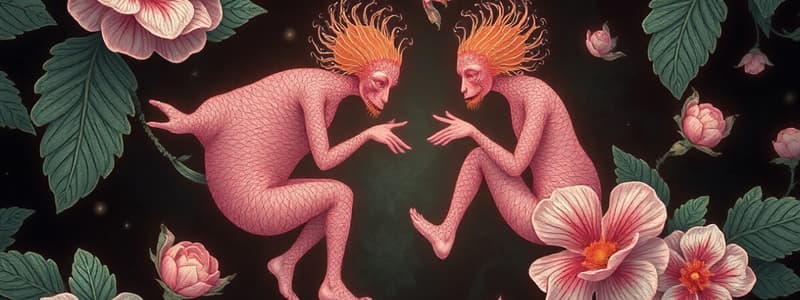Podcast
Questions and Answers
A scientist is studying a cell that is undergoing division. They observe that the resulting cells have half the number of chromosomes as the original cell. Which process is MOST likely occurring?
A scientist is studying a cell that is undergoing division. They observe that the resulting cells have half the number of chromosomes as the original cell. Which process is MOST likely occurring?
- Transcription, because it synthesizes RNA from a DNA template.
- Mitosis, because it produces identical daughter cells for growth and repair.
- Meiosis, because it reduces the chromosome number to produce gametes. (correct)
- Replication, because it doubles the DNA content before cell division.
Which of the following correctly orders the central dogma of molecular biology from start to finish?
Which of the following correctly orders the central dogma of molecular biology from start to finish?
- Replication, Translation, Transcription
- Transcription, Translation, Replication
- Replication, Transcription, Translation (correct)
- Translation, Replication, Transcription
Which of the following statements BEST describes the difference between primary and secondary sexual characteristics?
Which of the following statements BEST describes the difference between primary and secondary sexual characteristics?
- Primary sexual characteristics are found only in females, while secondary sexual characteristics are found only in males.
- Primary sexual characteristics develop during puberty, while secondary sexual characteristics are present at birth.
- Primary sexual characteristics are directly involved in reproduction, while secondary sexual characteristics are not. (correct)
- Primary sexual characteristics are influenced by hormones, while secondary sexual characteristics are not.
A couple is having difficulty conceiving. After preliminary testing, the doctor discovers the male has a low sperm count. Which part of the male reproductive system may be responsible for this?
A couple is having difficulty conceiving. After preliminary testing, the doctor discovers the male has a low sperm count. Which part of the male reproductive system may be responsible for this?
A woman is tracking her menstrual cycle and notices a surge in luteinizing hormone (LH). Which event is MOST likely to occur next?
A woman is tracking her menstrual cycle and notices a surge in luteinizing hormone (LH). Which event is MOST likely to occur next?
Flashcards
What is reproduction?
What is reproduction?
The production of new individuals or offspring.
What is asexual reproduction?
What is asexual reproduction?
A type of reproduction involving one parent and resulting in offspring genetically identical to the parent.
What is mitosis?
What is mitosis?
Cell division that results in two daughter cells each having the same number and kind of chromosomes as the parent nucleus, typical of ordinary tissue growth.
What are chromosomes?
What are chromosomes?
Signup and view all the flashcards
What is replication?
What is replication?
Signup and view all the flashcards
Study Notes
- Reproduction is the process by which living organisms create new individuals of the same kind
- There are two types of reproduction: sexual and asexual.
Sexual vs. Asexual Reproduction
- Sexual reproduction involves the fusion of gametes (sex cells) from two parents, resulting in offspring with genetic variation
- Asexual reproduction involves a single parent and produces offspring that are genetically identical to the parent.
Types of Asexual Reproduction
- Fission; a parent cell divides into two or more daughter cells
- Budding; a new organism grows from an outgrowth or bud on the parent
- Fragmentation; the body breaks into fragments, and each fragment develops into a new individual
- Parthenogenesis; an egg develops without being fertilized
- Vegetative Reproduction, new plants grow from parts of the parent plant
Mitosis vs. Meiosis
- Mitosis is cell division that results in two identical daughter cells, used for growth, repair, and asexual reproduction
- Meiosis is cell division that results in four genetically different daughter cells with half the number of chromosomes, used for sexual reproduction
Chromosomes
- Chromosomes are structures containing DNA that carry genetic information
- Chromosomes are made of DNA and proteins.
- Genes are segments of DNA that contain instructions for building proteins and determining traits.
Replication, Transcription, and Translation
- Replication is the process of copying DNA
- Transcription is the process of converting DNA into RNA
- Translation is the process of using RNA to synthesize proteins.
Male Reproductive System
- Testes produce sperm and testosterone
- Epididymis stores sperm
- Vas deferens transports sperm
- Seminal vesicles produce fluid for semen
- Prostate gland produces fluid for semen
- Urethra carries sperm and urine
- Penis delivers sperm
Female Reproductive System
- Ovaries produce eggs and hormones
- Fallopian tubes transport eggs
- Uterus supports fetal development
- Vagina receives sperm
Menstrual Cycle
- The menstrual cycle is a recurring series of changes in the female reproductive system
- Hormones involved include estrogen, progesterone, FSH, and LH
Pregnancy
- Pregnancy occurs when a sperm fertilizes an egg
- The fertilized egg implants in the uterus
- The fetus develops through trimesters
Birth
- Birth involves labor, delivery of the baby, and expulsion of the placenta
Primary vs. Secondary Sexual Characteristics
- Primary sexual characteristics are present at birth and involve the reproductive organs
- Examples include ovaries/testes
- Secondary sexual characteristics develop during puberty and are not directly involved in reproduction
- Examples include breast development, body hair, and voice changes
Contraceptives
- Contraceptives prevent pregnancy
- Methods include birth control pills, condoms, IUDs, and sterilization
STDs
- STDs are infections transmitted through sexual contact
- Examples include chlamydia, gonorrhea, syphilis, herpes, and HIV
Studying That Suits You
Use AI to generate personalized quizzes and flashcards to suit your learning preferences.





